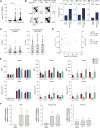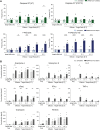Rapid Manufacturing of Highly Cytotoxic Clinical-Grade SARS-CoV-2-specific T Cell Products Covering SARS-CoV-2 and Its Variants for Adoptive T Cell Therapy
- PMID: 35480981
- PMCID: PMC9036989
- DOI: 10.3389/fbioe.2022.867042
Rapid Manufacturing of Highly Cytotoxic Clinical-Grade SARS-CoV-2-specific T Cell Products Covering SARS-CoV-2 and Its Variants for Adoptive T Cell Therapy
Abstract
Objectives: Evaluation of the feasibility of SARS-CoV-2-specific T cell manufacturing for adoptive T cell transfer in COVID-19 patients at risk to develop severe disease. Methods: Antiviral SARS-CoV-2-specific T cells were detected in blood of convalescent COVID-19 patients following stimulation with PepTivator SARS-CoV-2 Select using Interferon-gamma Enzyme-Linked Immunospot (IFN-γ ELISpot), SARS-CoV-2 T Cell Analysis Kit (Whole Blood) and Cytokine Secretion Assay (CSA) and were characterized with respect to memory phenotype, activation state and cytotoxic potential by multicolor flow cytometry, quantitative real-time PCR and multiplex analyses. Clinical-grade SARS-CoV-2-specific T cell products were generated by stimulation with MACS GMP PepTivator SARS-CoV-2 Select using CliniMACS Prodigy and CliniMACS Cytokine Capture System (IFN-gamma) (CCS). Functionality of enriched T cells was investigated in cytotoxicity assays and by multiplex analysis of secreted cytotoxic molecules upon target recognition. Results: Donor screening via IFN-γ ELISpot allows for pre-selection of potential donors for generation of SARS-CoV-2-specific T cells. Antiviral T cells reactive against PepTivator SARS-CoV-2 Select could be magnetically enriched from peripheral blood of convalescent COVID-19 patients by small-scale CSA resembling the clinical-grade CCS manufacturing process and showed an activated and cytotoxic T cell phenotype. Four clinical-grade SARS-CoV-2-specific T cell products were successfully generated with sufficient cell numbers and purities comparable to those observed in donor pretesting via CSA. The T cells in the generated products were shown to be capable to replicate, specifically recognize and kill target cells in vitro and secrete cytotoxic molecules upon target recognition. Cell viability, total CD3+ cell number, proliferative capacity and cytotoxic potential remained stable throughout storage of up to 72 h after end of leukapheresis. Conclusion: Clinical-grade SARS-CoV-2-specific T cells are functional, have proliferative capacity and target-specific cytotoxic potential. Their function and phenotype remain stable for several days after enrichment. The adoptive transfer of partially matched, viable human SARS-CoV-2-specific T lymphocytes collected from convalescent individuals may provide the opportunity to support the immune system of COVID-19 patients at risk for severe disease.
Keywords: COVID-19; SARS-CoV-2; adoptive T cell therapy; antiviral T cells; immunotherapy.
Copyright © 2022 Bonifacius, Tischer-Zimmermann, Santamorena, Mausberg, Schenk, Koch, Barnstorf-Brandes, Gödecke, Martens, Goudeva, Verboom, Wittig, Maecker-Kolhoff, Baurmann, Clark, Brauns, Simon, Lang, Cornely, Hallek, Blasczyk, Seiferling, Köhler and Eiz-Vesper.
Conflict of interest statement
OAC reports grants or contracts from Amplyx, Basilea, BMBF, Cidara, DZIF, EU-DG RTD (101037867), F2G, Gilead, Matinas, MedPace, MSD, Mundipharma, Octapharma, Pfizer, and Scynexis; Consulting fees from Amplyx, Biocon, Biosys, Cidara, Da Volterra, Gilead, Matinas, MedPace, Menarini, Molecular Partners, MSG-ERC, Noxxon, Octapharma, PSI, Scynexis, Seres; Honoraria for lectures from Abbott, Al-Jazeera Pharmaceuticals, Astellas, Grupo Biotoscana/United Medical/Knight, Hikma, MedScape, MedUpdate, Merck/MSD, Mylan, Pfizer; Payment for expert testimony from Cidara; Participation on a Data Safety Monitoring Board or Advisory Board from Actelion, Allecra, Cidara, Entasis, IQVIA, Jannsen, MedPace, Paratek, PSI, Shionogi; A patent at the German Patent and Trade Mark Office (DE 10 2021 113 007.7); Other interests from DGHO, DGI, ECMM, ISHAM, MSG-ERC, and Wiley. PK reports grants or contracts from German Federal Ministry of Research and Education (BMBF) B-FAST (Bundesweites Forschungsnetz Angewandte Surveillance und Testung) and NAPKON (Nationales Pandemie Kohorten Netz, German National Pandemic Cohort Network) of the Network University Medicine (NUM) and the State of North Rhine-Westphalia; Consulting fees Ambu GmbH, Gilead Sciences, Mundipharma Resarch Limited, Noxxon N.V. and Pfizer Pharma; Honoraria for lectures from Akademie für Infektionsmedizin e.V., Ambu GmbH, Astellas Pharma, BioRad Laboratories Inc., European Confederation of Medical Mycology, Gilead Sciences, GPR Academy Ruesselsheim, medupdate GmbH, MedMedia, MSD Sharp & Dohme GmbH, Pfizer Pharma GmbH, Scilink Comunicación Científica SC and University Hospital and LMU Munich; Participation on an Advisory Board from Ambu GmbH, Gilead Sciences, Mundipharma Resarch Limited and Pfizer Pharma; A pending patent currently reviewed at the German Patent and Trade Mark Office; Other non-financial interests from Elsevier, Wiley and Taylor & Francis online outside the submitted work. Authors HB, CC, OB, and MS are employed by the company Miltenyi Biotec B.V. & Co. KG, Bergisch Gladbach, Germany. Author DS is employed by the company Miltenyi Biomedicine GmbH, Bergisch Gladbach, Germany. The remaining authors declare that the research was conducted in the absence of any commercial or financial relationships that could be construed as a potential conflict of interest.
Figures




Similar articles
-
Manufacture and Characterization of Good Manufacturing Practice-Compliant SARS-COV-2 Cytotoxic T Lymphocytes.J Infect Dis. 2023 Mar 28;227(6):788-799. doi: 10.1093/infdis/jiac500. J Infect Dis. 2023. PMID: 36583990
-
Comparative Analysis of Clinical-Scale IFN-γ-Positive T-Cell Enrichment Using Partially and Fully Integrated Platforms.Front Immunol. 2016 Sep 30;7:393. doi: 10.3389/fimmu.2016.00393. eCollection 2016. Front Immunol. 2016. PMID: 27746781 Free PMC article.
-
Isolation of Functional SARS-CoV-2 Antigen-Specific T-Cells with Specific Viral Cytotoxic Activity for Adoptive Therapy of COVID-19.Biomedicines. 2022 Mar 9;10(3):630. doi: 10.3390/biomedicines10030630. Biomedicines. 2022. PMID: 35327433 Free PMC article.
-
Rapid generation of clinical-grade antiviral T cells: selection of suitable T-cell donors and GMP-compliant manufacturing of antiviral T cells.J Transl Med. 2014 Dec 16;12:336. doi: 10.1186/s12967-014-0336-5. J Transl Med. 2014. PMID: 25510656 Free PMC article.
-
Adoptive T-cell therapies to overcome T cell-dependent immune dysregulations in COVID-19.Turk J Biol. 2021 Dec 20;46(2):105-117. doi: 10.3906/biy-2109-85. eCollection 2022. Turk J Biol. 2021. PMID: 37533516 Free PMC article. Review.
Cited by
-
Antigen-Specific T Cells and SARS-CoV-2 Infection: Current Approaches and Future Possibilities.Int J Mol Sci. 2022 Dec 1;23(23):15122. doi: 10.3390/ijms232315122. Int J Mol Sci. 2022. PMID: 36499448 Free PMC article. Review.
-
Immune-Cell-Based Therapy for COVID-19: Current Status.Viruses. 2023 Oct 25;15(11):2148. doi: 10.3390/v15112148. Viruses. 2023. PMID: 38005826 Free PMC article. Review.
-
Long-Term Follow-Up after Adoptive Transfer of BK-Virus-Specific T Cells in Hematopoietic Stem Cell Transplant Recipients.Vaccines (Basel). 2023 Apr 14;11(4):845. doi: 10.3390/vaccines11040845. Vaccines (Basel). 2023. PMID: 37112757 Free PMC article.
-
Allogeneic, off-the-shelf, SARS-CoV-2-specific T cells (ALVR109) for the treatment of COVID-19 in high-risk patients.Haematologica. 2023 Jul 1;108(7):1840-1850. doi: 10.3324/haematol.2022.281946. Haematologica. 2023. PMID: 36373249 Free PMC article. Clinical Trial.
References
-
- Bergamaschi L., Mescia F., Turner L., Hanson A. L., Kotagiri P., Dunmore B. J., et al. (2021). Longitudinal Analysis Reveals that Delayed Bystander Cd8+ T Cell Activation and Early Immune Pathology Distinguish Severe Covid-19 from Mild Disease. Immunity 54, 1257–1275. e1258. 10.1016/j.immuni.2021.05.010 - DOI - PMC - PubMed
LinkOut - more resources
Full Text Sources
Other Literature Sources
Miscellaneous

